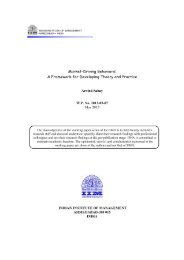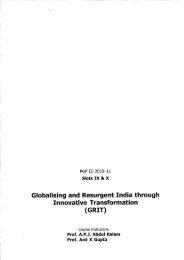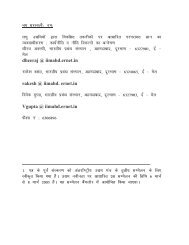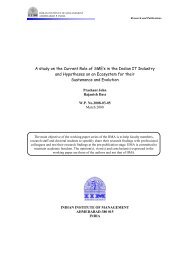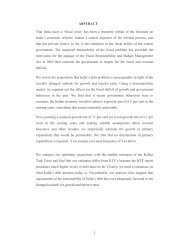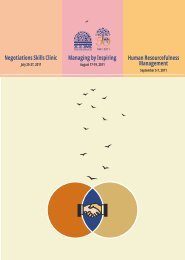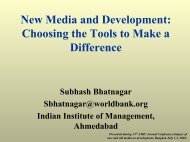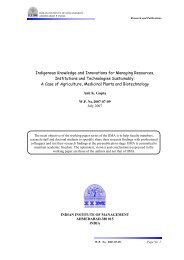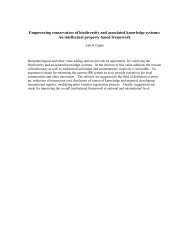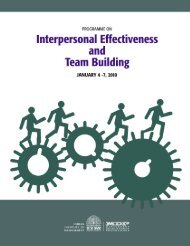related paper - Indian Institute of Management, Ahmedabad
related paper - Indian Institute of Management, Ahmedabad
related paper - Indian Institute of Management, Ahmedabad
Create successful ePaper yourself
Turn your PDF publications into a flip-book with our unique Google optimized e-Paper software.
22<br />
INTERNATIONAL JOURNAL OF KNOWLEDGE, CULTURE AND CHANGE MANAGEMENT, VOLUME 6<br />
tional innovation identified by Westera (2004: 508-<br />
510): substitution and transformation. The substitution<br />
strategy is an incremental approach whereas the<br />
transformational strategy proposes a “dramatic<br />
jump”. Each would ascribe different roles to the way<br />
in which technology-induced innovation has to be<br />
understood. Westera overcomes this simplistic dichotomy<br />
by applying Borgmann’s devices paradigm<br />
(making apparent the relationship between a commodity<br />
and its machinery, for instance, in any device<br />
or educational aid) and the concept <strong>of</strong> “focal practices”—activities<br />
that call for intrinsic involvement<br />
and strengthen the existential relationship <strong>of</strong> humans<br />
with the world (Borgmann 1984). He lists four principles<br />
that technology-based educational innovation<br />
can use: ensuring transparent and interactive devices;<br />
stressing products as carriers <strong>of</strong> meaning; going<br />
beyond efficiency; and paying attention to political<br />
meaning—“life demands a mixed mode <strong>of</strong> developing<br />
new ideas and preserving former achievements”<br />
(Westera 2004: 516). It is these principles, especially<br />
the last one, that provide the rationale for building<br />
on what the grassroots teacher-craftsmen know, by<br />
using alternative modes <strong>of</strong> communication in the<br />
diffusion and implementation episodic stages. An<br />
understanding <strong>of</strong> these principles would also help<br />
administrators integrate teacher workshops with<br />
multiple modes <strong>of</strong> diffusion—printed matter and<br />
website-based communication, for instance.<br />
Key administrators also need to be involved in all<br />
three episodes since, as Ramesh (2005) points out,<br />
while discussing innovation in bureaucratic systems,<br />
the genesis phase <strong>of</strong> innovation has not received as<br />
much attention as the implementation phase among<br />
bureaucrats working in public systems. He identifies<br />
‘framing’ an issue (what will be focused on) as important<br />
in understanding innovation in public systems,<br />
and suggests that the innovation should reach<br />
“a wider circle at the genesis or conceptual stage itself<br />
to gain acceptability” (ibid.: 47). Thus, the involvement<br />
<strong>of</strong> as many administrators as possible at<br />
the invention episode stage would help them frame<br />
the issue <strong>of</strong> valorising local innovations and knowledge<br />
in the context <strong>of</strong> wider diffusion and implementation.<br />
It would also help administrators move into<br />
the role <strong>of</strong> “policy entrepreneurs” (Mintrom and<br />
Vergari 1998), who as actors embedded in policy<br />
networks, will be able to direct the diffusion <strong>of</strong> innovations<br />
through their “direct and indirect contact<br />
with one another” (ibid.: 128). Playing this role is<br />
essential if bureaucrats committed to change are to<br />
develop a teacher network space and a culture supportive<br />
<strong>of</strong> decentralized pr<strong>of</strong>essional development<br />
within their own departments.<br />
This <strong>paper</strong> has focused on developing a culture<br />
that values a “learner-focused perspective” (in contrast<br />
to a training-focused perspective) and promotes<br />
a “network space for teacher development” in public<br />
educational systems responsible for pr<strong>of</strong>essional<br />
growth. The “Educational Innovation Bank” (EI<br />
Bank) described here builds on the concept <strong>of</strong> a<br />
clearinghouse and links the knowledge and innovations<br />
<strong>of</strong> outstanding teachers with networks that draw<br />
into them potential users <strong>of</strong> the Bank and other<br />
stakeholders. The implied valorisation <strong>of</strong> teachers’<br />
knowledge and innovations means that educational<br />
administrators have to learn to ‘learn from the<br />
grassroots’. The <strong>paper</strong> has drawn on processual theories<br />
<strong>of</strong> innovation which identify specific types <strong>of</strong><br />
networks for the three “episodes” <strong>of</strong> design and development,<br />
diffusion and implementation, to illustrate<br />
the kinds <strong>of</strong> knowledge transformation called for.<br />
The establishment <strong>of</strong> the EI Bank combines the social<br />
construction <strong>of</strong> knowledge among loose decentralized<br />
networks with knowledge objectification in the diffusion<br />
episode, through a process <strong>of</strong> screening and<br />
validating innovations, and converting them into<br />
user-friendly products. A second task for administrators<br />
is to link the innovations through broader networks<br />
that involve fellow pr<strong>of</strong>essionals and nonteacher<br />
experts, so that the design and diffusion<br />
episodes take root. The use <strong>of</strong> the EI Bank calls for<br />
a return to local networks, but networks <strong>of</strong> users, in<br />
order to appropriate the legitimised knowledge and<br />
objectified ideas in new contexts. Educational administrators<br />
have to play the role <strong>of</strong> policy entrepreneurs<br />
during these episodes <strong>of</strong> extended diffusion and implementation.<br />
These three tasks—developing an appreciation<br />
<strong>of</strong> a learner-focused perspective, converting<br />
validated local knowledge into ‘products’ through<br />
appropriate networks, and undertaking “policy entrepreneurship”—are<br />
crucial if administrators are to<br />
develop a culture <strong>of</strong> decentralized pr<strong>of</strong>essional development.<br />
Acknowledgements<br />
The project on which this <strong>paper</strong> draws upon was<br />
funded by a grant from the Sir Ratan Tata Trust,<br />
Mumbai, India. The author thanks Ms. Geeta Amin-<br />
Choudhury for coordinating the identification <strong>of</strong><br />
teachers and validation <strong>of</strong> their work.<br />
References<br />
Borgmann, A. 1984. Technology and the character <strong>of</strong> contemporary life. Chicago: University <strong>of</strong> Chicago Press.



